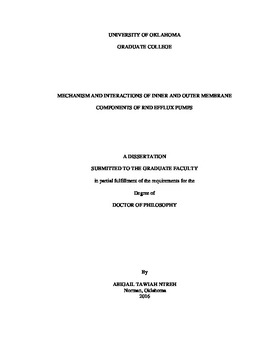| dc.contributor.advisor | Zgurskaya, Elena | |
| dc.contributor.author | Ntreh, Abigail | |
| dc.date.accessioned | 2016-08-19T18:27:04Z | |
| dc.date.available | 2016-08-19T18:27:04Z | |
| dc.date.issued | 2016-08 | |
| dc.identifier.uri | https://hdl.handle.net/11244/44931 | |
| dc.description.abstract | Since the discovery of antibiotics, an ongoing race commenced between society’s ability to develop drugs and resistant bacteria. The combat has led to many drug discoveries, but it has also led to different mechanisms of the pathogens to evade cell death. One major means of bacterial resistance is the association of membrane proteins to expel substrates from within the cell and out into the extracellular space. Some protein complexes are able to oust various drugs irrespective of structure or function of the antimicrobial; these are the multidrug resistance (MDR) efflux pumps. In the Gram-negative bacteria, these complexes are made up of an inner membrane transport protein (IMP), a periplasmic adapter protein (PAP) also commonly known as the membrane fusion protein (MFP), and an outer membrane protein (OMP). This assembled conduit acts as a canal to channel substrates from within the cytoplasm – substrates are repositioned outside the nearly impenetrable outer barrier.
Escherichia coli AcrAΒ-TolC is a constitutively expressed MDR pump. As one of the most studied systems, all three proteins have been crystalized, allowing for better understanding of the protein structures and properties. Many biochemical and structural experiments have aided predictions about protein-protein interactions and mechanisms of function of this protein complex. However, the homo-identity of all proteins in complex limits the isolation of roles and mechanistic characterization. The recently discovered TriABC-OpmH of Pseudomonas aeruginosa uniquely expresses two MFPs (TriA and TriB) and serves as a model system to study the assembly of efflux pumps and the function of MFPs in complex. In this study, we used the transporter protein AcrB to characterize kinetic parameters of efflux pump inhibitors (EPIs) provided by Basilea Pharmaceutica. Next, we used the TriABC complex as the means of studying the MFP-OMP amino acid interfaces. We investigated the role and assembly of TriA/B with the partnering OMP. We confirmed that MFPs stabilize interactions with the outer membrane channel protein, and we also assigned MFPs the role of opening the channel protein. Results isolated the role of each MFP within the functional dimeric complex. Additionally, we present low-resolution structures of TriABC showing different conformations of the TriAB MFPs. In vivo proteolysis experiments validate the structural findings, while presenting an OMP-dependent conformational change within one MFP. Together, this study provides new insight into the mechanism of MDR efflux complex, inspiring innovative drug targets and new drug designs to reciprocate and combat resistance of bacterial cells. | en_US |
| dc.language | en_US | en_US |
| dc.subject | mechanism, multidrug resistance, efflux pumps | en_US |
| dc.title | Mechanism and Interactions of Inner and Outer Membrane Components of RND Efflux Pumps | en_US |
| dc.contributor.committeeMember | Cichewicz, Robert | |
| dc.contributor.committeeMember | Rice, Charles | |
| dc.contributor.committeeMember | Rybenkov, Valentin | |
| dc.contributor.committeeMember | Dunn, Anne | |
| dc.date.manuscript | 2016-08-18 | |
| dc.thesis.degree | Ph.D. | en_US |
| ou.group | College of Arts and Sciences::Department of Chemistry and Biochemistry | en_US |
| shareok.nativefileaccess | restricted | en_US |
